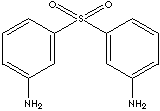PRODUCT IDENTIFICATION

H.S. CODE
TOXICITY
CLASSIFICATION
PHYSICAL AND CHEMICAL PROPERTIES
MELTING POINT
SOLUBILITY IN WATER
REFRACTIVE INDEX
APPLICATIONS
3,3'-Sulfonyldianiline is an analogue of dapsone, one of the most useful sulfones in phamacuetical field used as a parent compound in preparing sulfonamide antibacterial agents. 3,3'-Sulfonyldianiline is used in polymer industry as a cross linkage agent in manufacturing polysulfone amide engineering plastics.
Mercaptan: any of a class of organosulfur compounds is similar to the alcohol and phenol but containing a sulfur atom in place of the oxygen atom. Compounds containing -SH as the principal group directly attached to carbon are named 'thiols'. In substitutive nomenclature their names are formed by adding '-thiol' as a suffix to the name of the parent compound. When -SH is not the principal group, the prefix 'mercapto-' is placed before the name of the parent compound to denote an unsubstituted -SH group. 'thio' is a chemical prefix indicates the replacement of an oxygen in an acid radical by sulfur with a negative valence of 2. Sulfur analog of alcohol is called thiol (or mercaptan), and ether analog is called sulfide.
The first chemical contrast of thiols and sulfides with alcohols and ethers is acidity which is important in organic reactions. Thiols are stronger acids than relevant alcohols and phenols. Thiolate conjugate bases are easily formed, and are excellent nucleophiles in SN2 reactions of alkyl halides and tosylates. The nucleophilicity of sulfur is much greater than that of oxygen, resulting in a number of useful electrophilic substitution reaction that are rare by oxygen. For example, sulfides form (with alkyl halides) ternary sulfonium salts, in the same alkylattion of tert-amines quaternary ammonium salts, whereas ternary oxonium salts are prepared only under extream conditions. Without exception, sulfoxides, sulfinate salts and sulfite anion also alkylate on sulfur, despite of the partial negative formal charge on oxygen and partial positive charge on sulfur. The second character is the oxidation states of sulfur. Oxygen has only two oxidation states, whereas sulfur covers from –2 to +6 as follows:
- -2: Hydrogen Sulfide (H2S), sulfides, sulfonium ions
- -1: disulfides
- 0: S elemental, sulfoxides, sulfenic acids
- +2: sulfones, sulfinic acids
- +4: sulfonic acids, sulfite esters
- +6: sulfate esters
One more sulfur compound's contrast with oxygen analog is in oxidation chemistry. Oxidation of sulfur compounds changes the oxidation state of sulfur rather than carbon, whereas, oxidation of alcohols to aldehydes and ketones changes the oxidation state of carbon not oxygen. Thiols is oxidized to S-S single bond (disufide) which is stronger than O–O bond in peroxide. Disufide forms sulfenyl chlorides (with chlorine in mild condition) or sulfonic acids under harder condition. Oxidation of sulfides with hydrogen peroxide (or peracids) yields sulfoxides and then to sulfones. A certain sulfoxide compound such as dimethyl sulfoxide can be used as an effective oxygen source in the oxidation reaction of primary and secondary alcohols to aldehydes and ketones. DMSO easily is reduced to dimethyl sulfide and water is taken up by the electrophile. oxidation procedure is very mild and tolerates a variety of other functional groups, including those having oxidizable nitrogen and sulfur atoms.
The common examples of sulfone compounds are dapsone (4,4'-sulfonylbisbenzenamine) and its derivative. Dapsone (4,4'-sulfonylbisbenzenamine) is a parent compound in preparing sulfonamide antibacterial agents such as acedapsone, acetosulfone, glucosulfone, sulfoxone and solapsone. Dapsone and its derivatives have bacteriostatic activity against a broad spectrum of gram-negative and gram-positive organisms. Dapsone is a primary treatment for Dermatitis herpetiformis and in the treatment of leprosy (Mycobacterium leprae infections) leads to apparent improvementas. It is used in the prophylaxis of falciparum malaria. It is a white crystalline powder; melting point 175 - 180C; insoluble in water and vegetable oils. Dapsone is also widely used in polymer industry as a cross linkage agent in manufacturing polysulfone amide engineering plastics. Sulfone-containing engineering plastics are thermally stable and have high resistance property to acids and alkalis. Tazobactam is a penicillanic acid sulfone derivative which acts as a beta-lactamase inhibitor similar to sulbactam. Tazobactam is used in combination with piperacillin to widen the spectrum of activity. Sulfone class compounds which have a sulfonyl group attached to two carbon atoms are active as an antibiotic.
APPEARANCE
99.0% min
LOSS ON DRYING
0.5% max
MELTING POINT
165 - 170 C